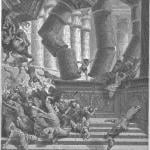
I’m revising a book that I once published, and thought that I might blog it — or, anyway, part of it — as I proceed:
On 23 September 1855, Elder George A. Smith of the Council of the Twelve stood up in the Bowery in Great Salt Lake City—the Tabernacle had not yet been built—and delivered what was, for the time and place, a very well informed and astonishingly positive sermon on Islam. “I am aware,” he said, “that it is a difficult matter to get an honest history of Mahometanism translated into any of the Christian languages.” He was reminded, when he read about Islam as portrayed by Western writers, of ex-Governor Thomas Ford’s biased History of Illinois, which managed to put the governor in a good light, and the persecuted and abused Latter-day Saints in quite a bad one.[1] “It is a hard matter, as I have said, to get an honest history of any nation or people by their enemies.” So he thereupon proceeded to give to his audience what was, as I say, a remarkably friendly account of Islam.
Concluding his remarks, though, and perhaps just a little bit embarrassed for having spoken in a Christian religious service on so unusual a topic, he asked his listeners to “excuse me for my Mahometan narrative.“[2] At that, though, Elder Parley P. Pratt jumped to his feet and approached the pulpit. “My brother, George A. Smith,” he remarked, “has wished us to excuse his Mahometan narration, but I would feel more like giving a vote of thanks to the Almighty and to His servant for so highly entertaining and instructing us.”[3]
Such instruction may well have been entertaining. Today, when we have more thrilling modes of entertainment than the spoken word of preaching, we may find it harder to regard instruction on a foreign culture as entertainment. But, if anything, knowledge of other cultures and civilizations is a far more pressing necessity today, than it ever was in the remote mountain valleys of mid-nineteenth century Deseret. It is especially pressing for us as we pursue our divinely-given mandate to take the gospel of Jesus Christ to the entire world.
As Marxism crumbles, one great ideology remains as an alternative to the liberal humanism that characterizes much of today’s West. That is Islam. And in Islam, perhaps more than in any other religion or ideology, it is the past that determines the present. We cannot understand today’s Islam without understanding events of the seventh century A.D., for it is through those events as well as through certain events of the intervening years, that Muslims understand themselves. In the next few chapters, therefore, I will offer a capsule history of the rise of Islam and a survey of the immense and wonderful civilization that emerged from it. I do not apologize for doing so. Failure to understand the religion of Islam and its seventh century roots has created many problems for the West. We owe it to ourselves—to say nothing of our obligation to our Muslim brothers and sisters—to overcome our misperceptions and our ignorance.
Mecca and the Quraysh
In the period immediately before the rise of Islam, a tribe known as Quraysh had assumed a special place in Arabian society. It had done so by taking control of the town of Mecca, a settlement that sat astride the major caravan route, dividing that route almost equally midway down the coast of Arabia.
Mecca was an important shrine center. It was built around a structure known as the Ka‘ba, which Arabian legend said had been erected by Abraham and his son Ishmael. The Ka‘ba stood as it stands today, in an enclosure known as the haram.[4] At certain times of the year, pilgrims came to the haram, in their thousands, from around the peninsula. This was a major source of revenue for the town, which had few natural resources of its own. But Mecca had also become, probably in the century or so preceding the rise of Islam, an important center of commerce. This was not unrelated to the town’s position as a center for pilgrimage. Central markets had been set up, and objects representing the gods of the entire peninsula had been placed in the Ka‘ba. (If that structure ever had been Abraham’s, it was certainly pagan now.) Fighting was banned during the market and pilgrimage times, and was always banned within the haram precincts. This created an international marketplace.
It is not possible to reconstruct with certainty the process by which Mecca transformed itself into a center for caravan trade as well as a marketplace, but it may have run something along the following lines: Caravans, as we know, had been running up and down the Arabian coast for centuries. The residents of Mecca, with their central position in the peninsula, and with their knowledge of the terrain and, most importantly, of where the few crucially important water holes were, had managed to establish themselves as guides to the caravans. They made a reasonably adequate living from such service. (They may also have run something of a protection racket: “Gee, that’s a nice caravan you have there. Lots of nice stuff. You sure are alone out here, though. It’d be a pity if something were to happen to you around these parts, what with nobody to help you and all. You know—just thinking, of course—for a nominal fee we could make it a whole lot less likely that something nasty would happen to you. What do you say?”) At some point in the sixth century, someone seems to have realized that it would make great sense, not to mention great profit, if the Meccans simply took over the trade themselves. Without their cooperation, nobody could compete with them, and they would be able to take all of the profits instead of just a fee and perhaps some protection money.
Mecca was roughly equidistant from both the Sasanian Persian empire and the Byzantine empire, which is to say from both the Christians and the Zoroastrians. This was fitting, since Mecca was pagan, and was thus, so to speak, neutral in the conflict between the two great religions. As we have seen, there were Christians and Jews in the Arabian peninsula, but their influence was quite limited in Mecca.
Another religious possibility, however, became available in and around the area of Mecca. A number of men known as hanifs—it would be claiming too much to describe them as a group, or as a movement—were growing dissatisfied with Arabian paganism.[5] In the increasingly sophisticated merchant society of Mecca, they were undoubtedly aware of the advanced religions of the Byzantines and the Persians, and they knew something of the Jews. They were puzzled that God appeared to have spoken to other peoples, but not to them. (The Arabic hanif could perhaps be loosely translated as “generic monotheist,” in contrast to the “brand name” monotheists of the great religious traditions.)[6] They were also dissatisfied with what was happening to their society.
Part of their dissatisfaction was based on the changing economics of Mecca. As residents of the city became involved in international caravan trade, it was predictable that some would grow wealthier than others. Whether for reasons of intelligence or diligence or sheer dumb luck, some people will always prosper more than others. But the rise of social and economic classes in a town that had really never known these classes was bound to have some effects. The old tribal values, under which people were responsible for their kinfolk, and especially for widows and orphans, began to break down. It had been easier, oddly enough, to live according to such values when everyone was on more or less the same level of poverty than it was proving to be when some were growing rich.[7] The temptation to plow one’s money right back into the business, or at least to spend it on some well-earned luxuries, and not to “waste” it on unproductive people, was just too strong.[8]
The problem, in the eyes of the hanifs, seems to have been that the tribal paganism of the Arabs did not oblige them to do any better than that. It had no ethical code to speak of, and suggested few standards of moral behavior. Allah was a distant being, too far away in the eyes of the pagans to be of any practical significance in everyday life. As for the jinn, well, they weren’t always so good themselves and could probably be bought off with a small offering every now and then. The hanifs were aware of the higher religions elsewhere, religions that made real moral demands upon their adherents and hence offered a moral contribution to society. But those religions were the religions of other people. The hanifs, for some reason, could not—or at least did not—bring themselves to accept either Christianity or Judaism or Zoroastrianism.
Several reasons may be offered for this. For one thing, the Jews of Arabia seemed not to encourage conversions. For another, given the political climate of the period, to have accepted either Christianity or Zoroastrianism might have implied that one was joining up with either the Byzantine or the Persian party, in much the same way that joining the Communist Party in the Congo would at one time have aligned someone, like it or not, with the Soviet Union. Finally, there was an expectant air in the Arabia of the period. If God had so far not seen fit to reveal himself to the Arabs, some seem to have felt, perhaps he soon would. (In this respect, the situation in Arabia may recall the mood in upstate New York, where many people were anticipating some sort of restoration, some kind of American revelation. Many of the early converts and future leaders of the Church came from a background of what is often called “Restorationism.”)
[1] Journal of Discourses 3:35.
[2] Journal of Discourses 3:37.
[3] Journal of Discourses 3:38.
[4] The root idea behind the Arabic root hrm is “to forbid” or “to be forbidden.” Most Westerners will be familiar with the word “harem” (Arabic harim; pronounced “hareem”), signifying a place for women, off-limits to all but certain men.
[5] The singular of the Arabic word hanif is pronounced “ha-neef.”
[6] I once thought that this suggestion was original with me. I have since found out, however, that Professor Marilyn Waldman of Ohio State University, an eminent American Islamicist, makes precisely the same comparison. So I must be right.
[7] The Book of Mormon, of course, illustrates such a tendency at numerous points in Nephite history.
[8] See King Benjamin’s remarks at Mosiah 4:16-26.











